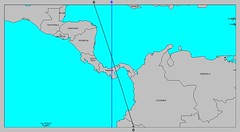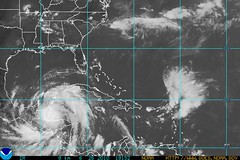 The Weather Alternative long-range for June 24-27, 2010 was posted on the preceding 8th of April. The forecast called for a strong low pressure area or possible tropical storm in and around the area of Panama, Costa Rica, and Honduras.
The Weather Alternative long-range for June 24-27, 2010 was posted on the preceding 8th of April. The forecast called for a strong low pressure area or possible tropical storm in and around the area of Panama, Costa Rica, and Honduras.On June 25th, Tropical Depression 1 formed 90 miles off the coast of Honduras fulfilling the long-range forecast. TD-1 has now become Tropical Storm Alex. The National Weather Service map at left shows the area in which TD-1 formed.
 Compare that area with the area that the astrometeorological map emphasized and that I used to formulate the forecast. It is this type of correspondence between planetary alignments and major weather patterns that has convinced just about every open-minded investigator as to the truth of astrometeorological influence.
Compare that area with the area that the astrometeorological map emphasized and that I used to formulate the forecast. It is this type of correspondence between planetary alignments and major weather patterns that has convinced just about every open-minded investigator as to the truth of astrometeorological influence.
The forecast also mentioned that other planetary alignments were affecting those same countries but on the Pacific side. As can be seen from the National Weather Service map at left, the influence of Tropical Storm Alex "spills over" in to that area as well.
Hurricane Season 2010--Caribbean, Mexico, Central America
Hurricane Season 2010--Forecasts for June
Hurricane Season 2010--Forecast for July
West Coast Weather Concerns July 23-31, 2010
Hurricane Season 2010--Forecasts for August
Hurricane Season 2010--Forecast for September
Hurricane Season 2010--Central America Part I
Hurricane Season 2010--Central America Part 2
Introduction to the Weather Alternative
How Long-Range Forecasts Are Made
Follow the Weather Alternative on Twitter Astroweatherman
God Makes Sense of the Universe’s Complexity
“In the last thirty-five years,” Craig said, “scientists have been stunned to discover that the Big Bang was not some chaotic, primordial event, but rather a highly ordered event that required an enormous amount of information. In fact, from the very moment of its inception, the universe had to be fine-tuned to an incomprehensible precision for the existence of life like ourselves. And that points in a very compelling way toward the existence of an Intelligent Designer.
“Scientifically speaking, it’s far more probable for a life-prohibiting universe to exist than a life-sustaining one. Life is balanced on a razor’s edge.”
As an example, he cited Hawking’s writings. “He has calculated,” Craig said, “that if the rate of the universe’s expansion one second after the Big Bang had been smaller by even one part in a hundred thousand million million, the universe would have collapsed into a fireball.”
In short order, Craig proceeded to go down a list of several other mind-boggling statistics to support his conclusion. Among them:
British physicist P. C. W. Davies has concluded the odds against the initial conditions being suitable for the formation of stars—a necessity for planets and thus life—is a one followed by at least a thousand billion billion zeroes.
Davies also estimated that if the strength of gravity or of the weak force were changed by only one part in a ten followed by a hundred zeroes, life could never have developed.
There are about fifty constants and quantities—for example, the amount of usable energy in the universe, the difference in mass between protons and neutrons, the ratios of the fundamental forces of nature, and the proportion of matter to antimatter—that must be balanced to a mathematically infinitesimal degree for any life to be possible. --The Case for Faith by Lee Strobel

No comments:
Post a Comment